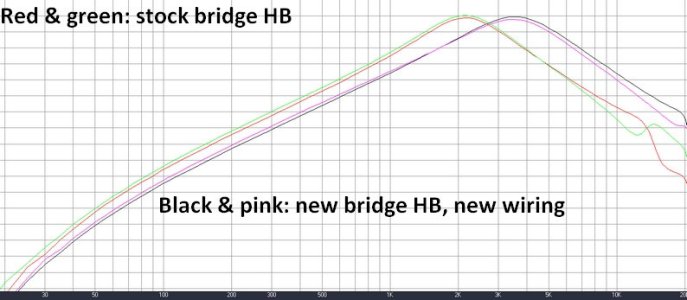I just read that titles back to myself and cringed… I never thought i would fall out of love with my CS Pearly Gates.
I put them in my CS R0 about 5 years ago, since the stock Custombuckers were just crap to my ears, and they made the guitar sing. They were heaven.
But of late, I haven’t been playing the LP much since I’ve either been busy with life or playing one of my other instruments. Anyway, i picked up the LP for a strum the other week and it just sounded meh… I had a supply of a few different ALNICO magnets at home from previous projects so i thought i would do some tinkering. In the last few weeks I’ve tried A4 and UOA5 in the bridge. The UOA5 was the winner. The problem atm is the neck.
Ive tried A4, UOA5 and short A5 in the neck but i just cant get to a point where im happy. The A4 sounded good but the notes just didn’t blend together well, the UOA5 sounded good but there is just something in the mids that I didn’t like in the neck position. I then went back to the stock A2 and the mids were good but the loose bottom end was still there (derr) so i then tried a short A5. It was an improvement, the mids were nice, there was some nice bite to it, but the bottom end is still too loose for my liking.
Obviously I’ve fiddled with pickup height and pole piece height, and while i can make it better or worse, i just cant seem to get it to where i want it.
Before i got back to the UOA5 (which was the lesser of all the evils) i thought i would join the forum to see what others have to say. Ive been a fan of, and using, SD pickups for probably 30+ years, so it was probably about time i joined anyway.
Anyway, what say you my learned brethren?
I put them in my CS R0 about 5 years ago, since the stock Custombuckers were just crap to my ears, and they made the guitar sing. They were heaven.
But of late, I haven’t been playing the LP much since I’ve either been busy with life or playing one of my other instruments. Anyway, i picked up the LP for a strum the other week and it just sounded meh… I had a supply of a few different ALNICO magnets at home from previous projects so i thought i would do some tinkering. In the last few weeks I’ve tried A4 and UOA5 in the bridge. The UOA5 was the winner. The problem atm is the neck.
Ive tried A4, UOA5 and short A5 in the neck but i just cant get to a point where im happy. The A4 sounded good but the notes just didn’t blend together well, the UOA5 sounded good but there is just something in the mids that I didn’t like in the neck position. I then went back to the stock A2 and the mids were good but the loose bottom end was still there (derr) so i then tried a short A5. It was an improvement, the mids were nice, there was some nice bite to it, but the bottom end is still too loose for my liking.
Obviously I’ve fiddled with pickup height and pole piece height, and while i can make it better or worse, i just cant seem to get it to where i want it.
Before i got back to the UOA5 (which was the lesser of all the evils) i thought i would join the forum to see what others have to say. Ive been a fan of, and using, SD pickups for probably 30+ years, so it was probably about time i joined anyway.
Anyway, what say you my learned brethren?

